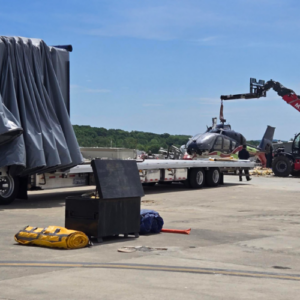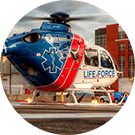You might have ridden in a helicopter for fun, work, or travel. Most people, however, have never been in a medical helicopter or seen one up close. It’s easy to think of them as just a way to get from one place to another. But when time is critical and a patient’s medical condition is critical, a medical helicopter provides more than just a ride—it delivers emergency care exactly when it’s needed.
Medical Helicopter vs. Transport Helicopters
Transport helicopters are mainly used to move people from one place to another. They have seats and sometimes audio equipment for passengers to enjoy a ride while sightseeing or being moved across distances. The difference between a transport or tour helicopter and a medical helicopter, however, is like the difference between a taxicab and ground ambulance. A medical helicopter is set up very differently than a transport helicopter because its job is different. It is designed to carry a patient and two crew members—usually a flight nurse and a flight paramedic. Inside, there are seats for the crew and a special bed called a gurney to keep the patient safe during the flight. Some medical helicopters load patients from the side, while others load from the back, but all are built with medical care in mind.
Medical helicopters have special equipment like heart monitors, ventilators (breathing machines), IV equipment, and a pharmacy of life-saving drugs. They also have extra safety features like collision avoidance systems, avionics and advanced pilot training that are not required for regular transport helicopters.
Medical Helicopter Crews
The crews on medical helicopters need special training for this kind of job. Paramedics usually have experience working on ground ambulances, and flight nurses often have worked in emergency rooms or intensive care units. Pilots also need special training, and many have military experience having logged many hours in the aircraft.
Financial Protection When You Need it Most
Securing medical transport via air ambulance does not have to put patients at financial risk. Only when transported by an AMCN provider, our members pay nothing out of pocket. When seconds countTM, air ambulance transport bills can be one less concern. Learn more at airmedcarenetwork.com.
Frequently Asked Questions:
If an AirMedCare Network Provider does not transport you, you will be responsible for payment. Our membership program only covers transports provided by our affiliates.
There is no limit to the number of transports a member may take in a year. Each transport is handled the same way and must be an emergent or time-sensitive transport as determined by a physician (or other appropriate provider) or first responder unaffiliated with AMCN.
With an AirMedCare Network membership, any person or persons who reside under one (residential) roof are covered. In the event we have a member who lives in a duplex or apartment complex, we designate the primary member’s residence/address— that is considered the “one roof”. Undergraduate college students can be covered under their parent’s membership as well as anyone previously residing in the household who is then moved to a permanent care facility.

From the Eye of the Storm: Air Evac Lifeteam 179 Rebuilds with Resilience
In early May, a string of devastating tornadoes swept across London, KY. Homes were flattened, vehicles were mangled and debris scattered across the county. London

The Importance of Air Ambulance Membership in Medical Emergencies
When it comes to medical emergencies, every second counts. Having access to air ambulance services can make a huge difference in a patient’s health outcome.

Understanding the Risks of Extreme Sports
Extreme sports offer an adrenaline rush and a sense of adventure that attracts millions of people. Understanding the risks associated with extreme sports is crucial




